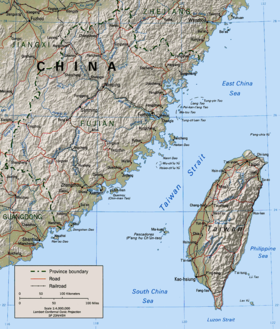From Wikipedia, the free encyclopedia
| Third Taiwan Strait Crisis | |||||||
|---|---|---|---|---|---|---|---|
 Taiwan Strait |
|||||||
|
|||||||
| Belligerents | |||||||
Supported by: |
|||||||
| Commanders and leaders | |||||||
| Units involved | |||||||
Contents
Lee's 1995 visit to Cornell
The crisis began when President Lee Teng-hui accepted an invitation from his alma mater, Cornell University to deliver a speech on "Taiwan's Democratization Experience". Seeking to diplomatically isolate the Republic of China, the PRC opposed such visits by ROC (commonly known as Taiwan) leaders. It argued that Lee harbored pro-Taiwan independence sentiments and was therefore a threat to stability in the region. A year earlier, in 1994, when President Lee's plane had stopped in Honolulu to refuel after a trip to South America, the U.S. government under President Bill Clinton refused Lee's request for a visa. Lee had been confined to the military airfield where he landed, forcing him to spend a night on his plane. A U.S. State Department official called the situation "embarrassing" and Lee complained that he was being treated as a second-class leader.After Lee had decided to visit Cornell, U.S. Secretary of State Warren Christopher assured PRC Foreign Minister Qian Qichen that a visa for Lee would be "inconsistent with [the U.S.'s] unofficial relationship [with Taiwan]." However, the humiliation from Lee's last visit caught the attention of many pro-Taiwan figures in the U.S. and this time, the United States Congress acted on Lee's behalf. In May 1995, a concurrent resolution asking the State Department to allow Lee to visit the U.S. passed the House 396 to 0 with 38 not voting, and the Senate 97 to 1 with 2 not voting.[1] The State Department relented on May 22, 1995 and the PRC condemned the U.S. for "ruining" Sino-American relations.
Lee spent June 9–10, 1995 in the U.S. at a Cornell Alumni reunion as the PRC state press branded him a "traitor" attempting to "split China".[2][3]
PRC military response
The PRC government was furious over the U.S.’s policy reversal. On July 7, 1995, the Xinhua News Agency announced missile tests to be conducted by the People's Liberation Army (PLA) and pointed out that this would endanger the peace and safety of the region. The PRC conducted tests from July 21 to 26 in an area only 60 kilometers north of ROC-held Pengjia Islet. At the same time, the PRC mobilized forces in Fujian. In the later part of July and early August numerous commentaries were published by Xinhua and the People's Daily condemning Lee and his cross-strait policies.Another set of missile firings, accompanied by live ammunition exercises, occurred from August 15 to 25, 1995. Naval exercises in August were followed by highly publicized amphibious assault exercises in November.
U.S. military response
The U.S. government responded by staging the biggest display of American military might in Asia since the Vietnam War.[4] President Clinton ordered additional ships into the region in March 1996. Two aircraft carrier battlegroups, Carrier Group Seven centered on USS Nimitz, and Carrier Group Five centered on USS Independence, were present in the region, and have been publicly claimed to have entered the Taiwan Strait. The Independence battle group was homeported in Japan at the time, and was in the area during the crisis, but reportedly remained outside of the effective exclusion zone delineated by Chinese weapons tests, posing no challenge to what some have interpreted as a de facto Chinese blockade of the strait.[citation needed] There is no evidence that the Nimitz battlegroup ever reached the vicinity of Taiwan.[citation needed]Run-up to the 1996 election
On March 8, 1996, also a presidential election year in the U.S., the U.S. government under President Clinton announced that it was deploying the Independence carrier battle group (CVBG), already stationed in the western Pacific, to international waters near Taiwan. On the following day, the PRC announced live-fire exercises to be conducted near Penghu from March 12–20. On March 11, the U.S. despatched Carrier Group Seven, centered around Nimitz, which steamed at high speed from the Persian Gulf. Tensions rose further on March 15 when Beijing announced a simulated amphibious assault planned for March 18–25.
Sending two carrier battle groups showed not only a symbolic gesture towards the ROC, but a readiness to fight on the part of the U.S. The ROC government and Democratic Progressive Party welcomed America's support, but staunch unificationist presidential candidate Lin Yang-kang and the PRC decried "foreign intervention."
Aware of U.S. Navy carrier battle groups' credible threat to the PLA Navy, the PRC decided to accelerate its military build up. Soon the People's Republic ordered Sovremenny class destroyers from Russia, a Cold-War era class designed to counter U.S. Navy carrier groups, allegedly in mid-December 1996 during the visit to Moscow by Chinese Premier Li Peng. The PRC subsequently ordered modern attack submarines (Kilo Class) and warplanes (76 Su-30MKK and 24 Su-30MK2) to counter the U.S. Navy's carrier battle groups.
The PRC's attempts at intimidation were counterproductive. Arousing more anger than fear, it boosted Lee by 5% in the polls, earning him a majority as opposed to a mere plurality.[citation needed] The military tests and exercises also strengthened the argument for further U.S. arms sales to the ROC and led to the strengthening of military ties between the U.S. and Japan, increasing the role Japan would play in defending Taiwan.
During the military exercises in March, there were preoccupations in Taiwan that the PRC would occupy some small island controlled by Taiwan. Many flights to the United States and Canada were full.[8] The then secretary general of National Security Council of Taiwan, Ding Mou-shih (丁懋時), flew to New York to meet Samuel Berger, Deputy National Security Advisor of the United States.[9]
No comments:
Post a Comment